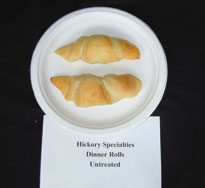
More recently, liquid smokes have gone beyond solely contributing smoke flavor to foods. They now function as antimicrobials, impart color, reduce warmed-over flavor and add texture. Many smoke ingredients impart very little or no smoke flavor at all.
"Liquid smoke ingredients have risen to a new level in helping food formulators solve problems," says Patrick Moeller, Ph.D., executive vice president for Hickory Specialties, Brentwood, Tenn. "There are new levels of flexibility with liquid smoke that go beyond adding flavor."
Flexibility in smoke ingredients comes from newly developed fractionation processes. Smoke flavors can be separated into various fractions with different functionalities.
Hickory Specialties' new line of functional smokes, Zesti Advantage, provides technologists tools for a variety of uses. A Natural Browning agent in the line has high stain and browning capabilities but imparts very little or no smoke flavor. The ingredient provides oven-roasted color, product texture improvements and shorter cook times at lower temperatures. Formulators can atomize, dip, drench, spray, or inject meats with the water-soluble, GRAS compound. The ingredient is derived from hardwood sawdust, so can be labeled "natural flavor."
Formulators use Zesti Advantage in a variety of products such as chicken parts, whole chickens, turkey breast, roast beef, pork loins, and turkey deli loaf. Other areas include potpies, microwave products and baked goods such as brown-and-serve rolls and crusted breads.
"Precooked poultry items that are browned in high speed browning ovens do not have time for proper color formation," says Moeller. "Using the browning agent adds color necessary for eye appeal." The natural ingredient can replace caramel color in clean label applications.
"Depending on the process you are using, you may not have to declare "natural smoke flavor" or "natural flavor" on the label," says Moeller. "If you apply the ingredient to the surface only, and then apply heat during the cooking process, it becomes part of the process, not an ingredient."
A big problem that smoke-derived products can help is warmed-over flavor (WOF). WOF occurs through the oxidation of fats in the meat after cooking. This causes meats to develop off-flavor notes.
"As more processors are moving to precooked products going to foodservice or directly into retail, WOF is a big concern," says Moeller. "Smoke ingredients with flavor can help mask WOF. Other flavorless smoke fractions can be used at low levels in marination systems to reduce the level of WOF."
Beef and pork are notorious for WOF, and to a lesser degree in poultry. Ground meat products are susceptible to WOF because of their increased surface area, exposing them to air.
Some smoke fractions contribute texture formation in meats. The ingredients form a skin-like surface crust that helps hold in moisture to make products juicier.
Liquid smoke also acts as a food safety tool, and can reduce or control pathogens such as E. coli in meats. The antibacterial properties of liquid smoke provide a great advantage to meat processors.
"We have smoke ingredients with reduced flavor that can be used to control the levels of bacteria in meats at usage levels of 0.15 to 0.3%, based on the weight of the meat," says Moeller.
Hickory Specialties produces three types of smoke flavors: mixed hardwood, hickory, and mesquite. Pure hickory tends to have a more robust, full smoky character that is generally associated with pork and some beef products. It provides a reddish-brown color. Pure mesquite, used mostly with poultry, provides a less intense golden yellow brown color.